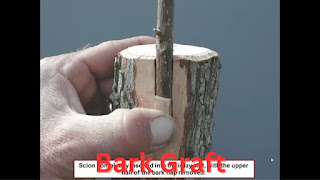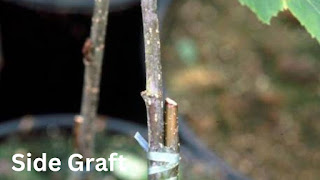The Art and Science of Grafting in Horticulture
Understanding Grafting:
Grafting is essentially the surgical union of two plant parts – the scion and the rootstock. The scion is the upper portion of the graft that carries the desired characteristics such as specific fruit varieties or ornamental traits. The rootstock, on the other hand, serves as the lower part and provides the root system and stability to the newly grafted plant.There are various types of Grafting:
Auto Graft:
- Autografting is a form of intraspecific grafting, meaning the graft involves two parts of the same plant species. One common method is called "self-grafting" or "auto-grafting." In this technique, a branch or shoot from a plant is grafted onto another part of the same plant.
- One of the main advantages of autografting is that it maintains genetic uniformity. Since both the scion and the rootstock come from the same plant, there is no genetic variation introduced, resulting in a clone of the original plant.
T-Budding:
- T-budding typically involves two plant parts – the bud or "shield" (scion) and the rootstock.
- A T-shaped incision is made in the bark of the rootstock. The horizontal cut forms the top of the "T," and the vertical cut forms the stem of the "T."
- The bud, or shield, is then carefully inserted into the T-shaped incision, ensuring a snug fit. The rootstock is the plant onto which the bud will be grafted.
- Prune the rootstock by making a straight, vertical cut (cleft) in the main trunk or branch. The depth of the cut depends on the size of the rootstock.
- With the help of a grafting knife or saw, create a wedge-shaped opening in the center of the cleft.
- Trim the scion & the scion should be about 4 to 6 inches long and have at least one dormant bud.
- Insert the prepared scion into the cleft of the rootstock, making sure the wedge of the scion fits snugly into the cleft. Seal the cut surfaces with grafting wax.
- Choose a healthy and disease-free scion and rootstock. The scion should have at least one dormant bud.
- Trim the rootstock by making a straight, horizontal cut through the bark.
- Trim the scion to have a wedge or tongue shape at its base. Insert the prepared scion into the cut in the rootstock, ensuring a tight fit between the cambium layers of both scion and rootstock. Use rubber bands or grafting tape to secure the scion in place.
- Make a diagonal cut on both the scion and the rootstock. The cuts should be sloping, creating matching slopes that fit together.
- In the center of each diagonal cut, create a small vertical cut or tongue. The tongues on both scion and rootstock should fit together like a puzzle piece.
- Insert the prepared scion into the matching cut on the rootstock, Use rubber bands or grafting tape to tightly secure the scion in place.
- Trim the rootstock by making a straight, vertical cut through the bark. The cut should extend upward, creating a flat surface for the scion. Make a horizontal cut into the side of the rootstock, exposing the cambium layer.
- Trim the scion to have a matching angle to fit into the cut made on the rootstock which ensures maximum contact with the cambium layer.
- Insert the prepared scion into the cut made on the side of the rootstock, ensuring a tight and secure fit & apply grafting wax.
- Introduce an intermediate plant (inters tock) between the scion and rootstock. The inters tock is selected for its compatibility with both the scion and rootstock.
- Graft the scion onto the inters tock using a suitable grafting method (e.g., whip-and-tongue grafting). Allow the graft to heal.
- Graft the inters tock, now carrying the scion, onto the rootstock. This creates a three-part graft with the scion, inters tock, and rootstock.
- Bridge grafting is typically employed when a tree has suffered damage or girdling
- Identify healthy sections of the tree above and below the damaged or girdled area.
- Cut scion wood into wedge-shaped pieces. Insert these scion pieces under the flaps of bark on both sides of the damaged area, creating a bridge that spans the damaged section.
Applications of Grafting:
Fruit Tree Improvement:
- Grafting allows growers to combine the desirable traits of one fruit variety with the rootstock's hardiness or disease resistance.
Ornamental Plant Propagation:
- Grafting is widely employed in the ornamental industry to produce unique flower colors, forms, or growth habits.
Science Behind Grafting:
The success of grafting relies on the compatibility of the scion and rootstock, ensuring that the cambium layers align for vascular connection. The cambium is a thin layer of cells responsible for the plant's growth, and when properly aligned during grafting, it forms a bridge for nutrient and water transfer between scion and rootstock.
Conclusion:
Grafting is a versatile and time-tested horticultural technique that allows for the creation of unique plant varieties and the restoration of damaged plants. Whether it's improving fruit quality, enhancing ornamental characteristics, or rescuing ailing trees, grafting remains a valuable tool for gardeners, arborists, and plant enthusiasts alike. As we continue to explore and refine this ancient practice, the art and science of grafting will undoubtedly contribute to the ever-evolving world of horticulture.









.jpg)

No comments:
Post a Comment